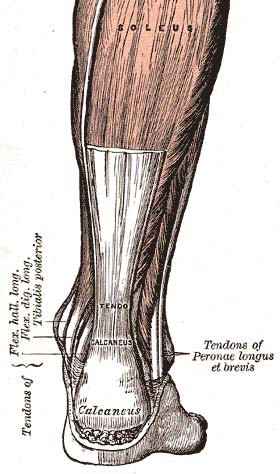
Image via Wikipedia
If there’s one thing that can stop you dead in your tracks, it’s a pulled calf muscle. The word “pulled muscle” usually refers to an involuntary, painful spasm that occurs without a single, forceful impact which characterizes a typical muscle sprain/ strain.
You’ll feel your calf muscle contract by itself, and sometimes oscillate (twitch) reflexively causing you to quickly bend your knee to stop the progressing contraction. A deep, painful sensation is felt at the myofascial junction that eventually forms the Achilles tendon. If you’re lucky, sometimes you can prevent it from spasming if you immediately stop what you are doing at the first sign of the spasm (jerky, involuntary twitching) and focus on relaxing the leg.
Basically, pulled calf muscles occur after prolonged exercise of the legs, such as in long distance running, cycling, swimming, and uphill climbing. Muscle contraction is mediated by a complex biological pathway that involves electrolytes, mainly calcium, phosphorus, and sodium ions. These ions need to be available in order for the actin and myosin fibers to “ratchet” properly during contraction and relaxation. Prolonged leg exertion, without replenishing lost electrolytes can lead to muscle spasms. This is why sports teams use Gatorade to hydrate the athletes, and protect against muscle injuries.
Nocturnal (night) calf muscle spasms are a common occurrence in 2nd and 3rd trimester pregnant women. It it thought to be caused by low electrolytes as a result of the pregnancy. Eating foods rich in calcium and phosphorus can reduce these symptoms.
Lactic acid buildup in the myofascial sheath can also be a contributing factor to pulled muscles. If more lactic acid is created that can be neutralized by the body, it can affect muscle contraction.
TREATMENT:
If the spasm got you before you could stop it, don’t panic. The pain will work itself out in about 30 minutes. If it is still present after an hour, see your doctor.
Drink an athletic sport drink to replenish your electrolytes. If you have multivitamins at home, take 2 tablets with water.
Wrap an icepack around your calf, especially over the end of the muscle belly (that’s the start of the Achilles tendon); hold in place for 20 minutes.
Gradually, extend your knee; if you feel twitching again, stop and return to flexed knee position, ice applied; give it another 10 minutes.
When you can extend the knee fully without pain (all this is done sitting on the floor), gently test the calf muscle by bending your foot upwards toward your knee (called dorsiflexion). Do this very slowly, and hold the stretch for10 seconds; repeat five times.
Next, attempt to walk. That should be the end of your painful episode! In the future, before you engage in arduous exercise involving a lot of legwork, load up on foods rich in electrolytes. Most of those sports snacks include them, like Cliff Bars and others. Try to get the healthy ones.







